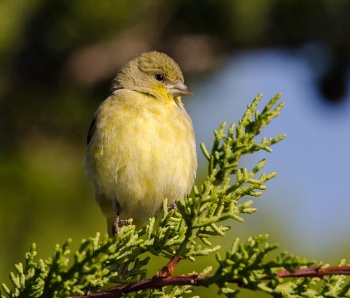
Photo © by Mary Claypool
Lake Murray, San Diego, California, 24 February 2005
Alternative name: Dark-backed Goldfinch, Arkansas Goldfinch[2]
- Spinus psaltria
Carduelis psaltria, Astragalinus psaltria[2]
Identification
9–11 cm (3 ½-4¼ in)
- Yellow underparts
- White patches on wings at base of primaries are diagnostic
- Black or green upperparts
- Long conical bill
- Undertail has broad black tip
Females: olive-green upperparts, yellow-buff underparts
Similar Species
American Goldfinch has yellow back and white undertail coverts; lacks the black terminal band on the underside of the tail.
Variations
Adult males occur in two color morphs, green and black. Black-backed types predominate in the eastern part of their range while green-backed are more common in the west. Females are also polymorphic, with a rare pale type lacking yellow on the underparts except for a small area on the chin and malar region.
Distribution
Southwestern United States through Mexico and Central America to Colombia, Venezuela, Ecuador, and Peru in South America.
Northern populations migratory, southernmost US and the rest are residents year round. Casual vagrant east to the Mississippi and Missouri rivers.
Taxonomy
Formerly included in genus Carduelis.
Subspecies[1]
Five subspecies are recognized:
- S. p. hesperophilus:
- Western US to southern Baja California and north-western Mexico
- S. p. witti:
- Tres Marías Islands (off western Mexico)
- S. p. psaltria:
- S. p. jouyi:
- South-eastern Mexico (Yucatán Peninsula and northern Quintana Roo)
- S. p. colombianus.:
Habitat
Open habitats with scattered trees and brush, especially near water. Common near human dwellings; comes readily to feeders, especially for thistle seed.
Behaviour
Diet
The diet includes tree buds and weed seeds. Favors thistle seed and sunflowers.
Breeding
They build a cup-shaped nest of plant material in a bush or tree and 3-4 blue-white eggs are laid.
References
- Clements, J. F., T. S. Schulenberg, M. J. Iliff, D. Roberson, T. A. Fredericks, B. L. Sullivan, and C. L. Wood. 2018. The eBird/Clements checklist of birds of the world: v2018. Downloaded from http://www.birds.cornell.edu/clementschecklist/download/
- Avibase
- Wikipedia contributors. (2019, January 29). Lesser goldfinch. In Wikipedia, The Free Encyclopedia. Retrieved 09:11, February 5, 2019, from https://en.wikipedia.org/w/index.php?title=Lesser_goldfinch&oldid=880764736
- Clement, P. (2019). Lesser Goldfinch (Spinus psaltria). In: del Hoyo, J., Elliott, A., Sargatal, J., Christie, D.A. & de Juana, E. (eds.). Handbook of the Birds of the World Alive. Lynx Edicions, Barcelona. (retrieved from https://www.hbw.com/node/61357 on 4 February 2019).
- Watt, D. J. and E. J. Willoughby (2014). Lesser Goldfinch (Spinus psaltria), version 2.0. In The Birds of North America (A. F. Poole, Editor). Cornell Lab of Ornithology, Ithaca, NY, USA. https://doi.org/10.2173/bna.392
Recommended Citation
- BirdForum Opus contributors. (2024) Lesser Goldfinch. In: BirdForum, the forum for wild birds and birding. Retrieved 27 July 2024 from https://www.birdforum.net/opus/Lesser_Goldfinch
External Links
GSearch checked for 2020 platform.1





